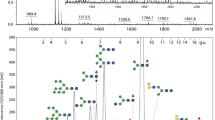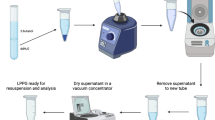Abstract
The glycosylation alterations of mouse small intestinal mucins during a 12-day infectious cycle caused by the parasite Nippostrongylus brasiliensis have been studied. The guanidinium chloride insoluble mucins were isolated at day 0 to 12 from the small intestine of infected and non-infected C57BL/6 mice. The O-linked oligosaccharides were released by reductive β-elimination from the mucins and separated into neutral, sialylated and sulfated fractions. All fractions were analyzed by monosaccharide composition analysis and the neutral oligosaccharides were structurally characterized by gas chromatography/mass spectrometry. Two oligosaccharides containing blood group H-type epitopes (Fucα1-2Gal-) were transiently expressed with a maximum at day 6. Additional oligosaccharides with the common structure HexNAc-Gal-3GalNAcol were transiently induced with a maximum at day 10. Northern blot analysis on total RNA showed a transient expression at day 4–6 of the Fut2 gene encoding a Fucα1-2 fucosyltransferase, probably responsible for the detected blood group H-type epitopes. Comparisons with the corresponding infection in rat studied previously, revealed structurally different alterations, although occurring as transient events in both species. Both showed an induced blood group-type transferase halfway through the infection (a blood group A transferase in rat) and an induced transferase adding a terminal GalNAc (to a sialic acid- containing epitope in rat) towards the end of the infection. These differences between closely related species suggest rapid evolutionary alterations in glycosyltransferase expression.
Similar content being viewed by others
References
Moniaux N, Escande F, Porchet N, Aubert JP, Batra SK, Structural organization and classification of the human mucin genes, Front Biosci 6, D1192–206 (2001).
Gendler SJ, Spicer AP, Epithelial mucin genes, Annu Rev Physiol 57, 607–34 (1995).
Gum JR Jr, Crawley SC, Hicks JW, Szymkowski DE, Kim YS, MUC17, a novel membrane-tethered mucin, Biochem Biophys Res Commun 291, 466–75 (2002).
Carlstedt I, Herrmann A, Karlsson H, Sheehan J, Fransson L Å, Hansson GC, Characterization of two different glycosylated domains from the insoluble mucin complex of rat small intestine, J Biol Chem 268, 18771–81 (1993).
Karlsson NG, Olson FJ, Jovall P Å, Andersch Y, Enerbäck L, Hansson GC, Identification of transient glycosylation alterations of sialylated mucin oligosaccharides during infection by the rat intestinal parasite Nippostrongylus brasiliensis, Biochem J 350 (Pt 3), 805–14 (2000).
Olson FJ, Johansson ME, Klinga-Levan K, Bouhours D, Enerbäck L, Hansson GC, Karlsson NG, Blood group A glycosyltransferase occurring as alleles with high sequence difference is transiently induced during a Nippostrongylus brasiliensis parasite infection, J Biol Chem 277, 15044–52 (2002).
Wingren U, Enerbäck L, Ahlman H, Allenmark S, Dahlström A, Amines of the mucosal mast cell of the gut in normal and nematode infected rats, Histochemistry 77, 145–58 (1983).
Thornton DJ, Holmes DF, Sheehan JK, Carlstedt I, Quantitation of mucus glycoproteins blotted onto nitrocellulose membranes, Anal Biochem 182, 160–4 (1989).
Karlsson NG, Karlsson H, Hansson GC, Strategy for the investigation of O-linked oligosaccharides from mucins based on the separation into neutral, sialic acid-and sulfate-containing species, Glycoconj J 12, 69–76 (1995).
Prakobphol A, Thomsson KA, Hansson GC, Rosen SD, Singer MS, Phillips NJ, Medzihradszky KF, Burlingame AL, Leffler H, Fisher SJ, Human low-molecular-weight salivary mucin expresses the sialyl Lewis x determinant and has L-selectin ligand activity, Biochemistry 37, 4916–27 (1998).
Thomsson KA, Carlstedt I, Karlsson NG, Karlsson H, Hansson GC, Different O-glycosylation of respiratory mucin glycopeptides from a patient with cystic fibrosis, Glycoconj J 15, 823–33 (1998).
Thomsson KA, Karlsson H, Hansson GC, Sequencing of sulfated oligosaccharides from mucins by liquid chromatography and electrospray ionization tandem mass spectrometry, Anal Chem 72, 4543–9 (2000).
Karlsson NG, Hansson GC, Analysis of monosaccharide composition of mucin oligosaccharide alditols by high-performance anionexchange chromatography, Anal Biochem 224, 538–41 (1995).
MacDonald RJ, Swift GH, Przybyla AE, Chirgwin JM, Isolation of RNA using guanidinium salts, Methods Enzymol 152, 219–27 (1987).
Baeckström D, Nilsson O, Price MR, Lindholm L, Hansson GC, Discrimination of MUC1 mucins from other sialyl-Le(a)-carrying glycoproteins produced by colon carcinoma cells using a novel monoclonal antibody, Cancer Res 53, 755–61 (1993).
Domino SE, Zhang L, Lowe JB, Molecular cloning, genomic mapping, and expression of two secretor blood group alpha (1,2)fucosyltransferase genes differentially regulated in mouse uterine epithelium and gastrointestinal tract, J Biol Chem 276, 23748–56 (2001).
Miller HR, Gastrointestinal mucus, a medium for survival and for elimination of parasitic nematodes and protozoa, Parasitology 94 (Suppl), S77–100 (1987).
Thomsson KA, Hinojosa-Kurtzberg M, Axelsson KA, Domino SE, Lowe JB, Gendler SJ, Hansson GC, Intestinal mucins from cystic fibrosis mice show increased fucosylation due to an induced Fucalpha1-2 glycosyltransferase, Biochem J 367, 609–16 (2002).
Karlsson H, Carlstedt I, Hansson GC, Rapid characterization of mucin oligosaccharides from rat small intestine with gas chromatography-mass spectrometry, FEBS Lett 226, 23–7 (1987).
Karlsson H, Carlstedt I, Hansson GC, The use of gas chromatography and gas chromatography-mass spectrometry for the characterization of permethylated oligosaccharides with molecular mass up to 2300, Anal Biochem 182, 438–46 (1989).
Smith EL, McKibbin JM, Karlsson KA, Pascher I, Samuelsson BE, Characterization by mass spectrometry of blood group A active glycolipids from human and dog small intestins, Biochemistry 14, 2120–4 (1975).
Sheehan JK, Thornton DJ, Howard M, Carlstedt I, Corfield AP, Paraskeva C, Biosynthesis of the MUC2 mucin: Evidence for a slow assembly of fully glycosylated units, Biochem J 315(Pt 3), 1055–60 (1996).
Bry L, Falk PG, Midtvedt T, Gordon JI, A model of host-microbial interactions in an open mammalian ecosystem, Science 273, 1380–3 (1996).
Karlsson KA, Animal glycosphingolipids as membrane attachment sites for bacteria, Annu Rev Biochem 58, 309–50 (1989).
Hansson GC, Structural aspects of blood group glycosphingolipids in the gastrointestinal tract, Adv Exp Med Biol 228, 465–94 (1988).
Gagneux P, Varki A, Evolutionary considerations in relating oligosaccharide diversity to biological function, Glycobiology 9, 747–55 (1999).
Lin B, Hayashi Y, Saito M, Sakakibara Y, Yanagisawa M, Iwamori M, GDP-fucose: Beta-galactoside alpha1,2-fucosyltransferase, MFUT-II, and not MFUT-I or-III, is induced in a restricted region of the digestive tract of germ-free mice by host-microbe interactions and cycloheximide, Biochim Biophys Acta 1487, 275–85 (2000).
Lin B, Saito M, Sakakibara Y, Hayashi Y, Yanagisawa M, Iwamori M, Characterization of three members of murine alpha1,2-fucosyltransferases: Change in the expression of the Se gene in the intestine of mice after administration of microbes, Arch Biochem Biophys 388, 207–15 (2001).
Author information
Authors and Affiliations
Corresponding author
Rights and permissions
About this article
Cite this article
Holmén, J.M., Olson, F.J., Karlsson, H. et al. Two glycosylation alterations of mouse intestinal mucins due to infection caused by the parasite Nippostrongylus brasiliensis . Glycoconj J 19, 67–75 (2002). https://doi.org/10.1023/A:1022589015687
Issue Date:
DOI: https://doi.org/10.1023/A:1022589015687




